
Fifty years after its inception, OKR remains the dominant productivity framework worldwide. Modern OKR software makes streamlining your goal-setting and alignment processes easier, bringing focus and clarity to your work. Say goodbye to manual strategies and spreadsheets and hello to real-time reporting, custom OKR structures, and interactive roadmaps.
What Is OKR Software?
OKR software is a goal management and performance tracking tool that helps organizations and individuals set, track, and achieve their goals. OKR stands for Objectives and Key Results, a framework for setting and monitoring specific, measurable, achievable, relevant, and time-bound (SMART) goals. It provides additional incentives to achieve short-term and long-term goals and is generally considered one of the best ways to improve the team's productivity.
OKR software can help organizations implement this framework and align their goals and strategies across departments, teams, and individual employees. It includes goal tracking, progress reporting, real-time goal updates, and performance analytics.
OKR software can be a valuable tool for businesses of all sizes, from startups to large corporations, helping them track progress and make data-driven decisions to achieve their goals and drive growth.
How Do I Choose OKR Software?
Choosing the right OKR software depends on your organization's specific needs and goals. Here are some factors to consider when selecting OKR software:
Features and functionality: Consider what features you need in OKR software, such as goal tracking, progress reporting, real-time goal updates, and performance analytics. Ensure the software you choose has features that meet your organization's needs.
Ease of use: Consider how easy you can use the software for setting and tracking goals, as well as for reporting progress. Make sure the software is intuitive and user-friendly.
Integration with other tools: Consider how well the OKR software integrates with the other tools and platforms you use, such as project management software, productivity tools, and business intelligence platforms.
Cost: Consider the cost of the software, including additional costs such as support, training, and integration with other tools. Make sure the software fits within your budget.
Customer support: Consider the quality of customer support the software provider offers. Make sure you can access reliable and responsive support when needed.
Data privacy and security: Consider the data privacy and security measures in place to protect sensitive information. Make sure the software you choose has robust security measures.
Scalability: Consider the scalability of the software, especially if you plan to grow your organization in the future. Make sure the software can grow with your organization.
Considering these factors, you can choose an OKR software that meets your organization's specific needs and helps you achieve your goals.
Best OKR Software
On the market today, there is a lot of great OKR software. So, your biggest problem might be picking the one that works best for your new business. Don't worry; we reviewed them and made a short list of the best OKR software.
Here are some of the best OKR software for startups in 2023:
1. Quantive

Quantive Results (formerly Gtmhub) is a strategy execution platform based on the Objectives and Key Results (OKR) methodology. The platform helps organizations to embed strategic context, priorities, and progress into their day-to-day operations, providing more significant focus, alignment, and transparency. It is massive and best used as a single unit since otherwise, you might end up with a lot of busy work. However, if you are willing to make a sacrifice, it might be worth it.
Like other OKR management tools, Quantive helps organizations align their efforts with their company's goals, unify and align their strategy, people, and processes, and gain real-time insights into their performance. With its wide range of features and capabilities, Quantive Results is the ideal solution for organizations looking to close the gap between strategy and execution.
Key Features
Alignment View. It has a single dashboard that showcases the company's performance on the strategic level.
Marketplace. Over 170 native integrations, templates, and apps are available on the Marketplace from Quantive's partners.
Insightboards. A comprehensive view of the organization's performance through customizable dashboards.
Whiteboards. A dedicated OKR brainstorming tool that helps you collaborate with your team members.
KPI Dashboards. For those who do not feel like OKRs are enough and want a separate framework to supplement them.
2. Leapsome

Leapsome is a comprehensive Human Resource platform that caters to organizations of all sizes. The platform offers a range of tools and features that help employees align and develop through various performance management and employee engagement initiatives. These features include goal and objectives management, performance evaluations, employee engagement surveys, 360-degree feedback, recognition programs, one-on-one meetings, and employee onboarding and learning.
Leapsome is not quite the OKR management solution you are probably looking for, but with some creative thinking, it can fulfill this function, too. Companies such as Spotify, Trivago, and Babbel adopted Leapsome to enhance their people management processes and have seen positive results. That said, it might be a better solution for those who already use Leapsome to manage their personnel and don't want to add a separate new tool for OKRs. Otherwise, Leapsome's offers are remarkably basic, and you will feel its limitations sooner or later.
Key Features
360 Degree Feedback Software. Provides a comprehensive view of an employee's strengths and areas for improvement through multiple perspectives
Asynchronous Learning. Enables employees to learn at their own pace and schedule, improving the overall learning experience
Built-in Course Authoring. Provides a platform for organizations to create and manage learning content easily
Career Development. Provides a roadmap for employee career progression, enabling organizations to retain and develop their best talent
Compensation Management Software. Offers tools to manage and track employee compensation and benefits
3. Weekdone
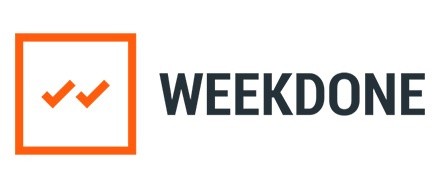
Since 2013, Weekdone has been a comprehensive OKR software that helps organizations create structured goals and long-term team objectives. It brings a lot of social media-like gamification features into the OKR world, and while this is not entirely correct according to the classical OKR framework, the idea has found some fans.
Weekdone offers a platform for setting and achieving goals and objectives, making it a trusted and innovative solution for leaders and teams. Its user-friendly interface and features promote employee engagement and motivation, making it an essential tool for companies looking to improve their performance and results.
Features
Linking Team OKRs to Company Objectives. Provides a comprehensive view of progress across all teams
Weekly Employee Plans. Supports the creation of weekly employee plans that drive quarterly OKRs forward, promoting focus and accountability
Automated Progress Reports and TV Dashboard. Provides weekly automated progress reports and ensures progress is tracked and communicated effectively
Online Learning Center. Provides everything you need to know about the OKR methodology and the Weekdone software, helping organizations understand and adopt the OKR process
OKR Wizard and Examples. Provide step-by-step guidance for setting quality objectives and key results, helping organizations ensure their OKRs are aligned with their goals and objectives
4. Perdoo

Perdoo is OKR tracking software that provides all the necessary tools and expert coaching to align everyone with the company's strategy and goals. It is probably the most comprehensive and extensive tool on this list, simultaneously an advantage and a massive downside.
Even more so than Quantive, Perdoo encourages you to go all-in and transfer your entire workflow to their tools, which is a bit much if all you need is OKRs.
Features
OKR Visualization. Lets your employees see how their tasks contribute to the company's strategic goal
Confidence Levels. Allows users to indicate their confidence level in achieving their objectives, providing valuable insight into the organization's progress
KPI Management. Provides a centralized system for managing key performance indicators (KPIs), enabling organizations to track their progress and make data-driven decisions
Single Sign-On (SSO). Enables users to access Perdoo using their existing login credentials, streamlining the login process and improving security
Reporting (Analytics). Provides robust reporting capabilities, including real-time analytics, to help organizations track their progress and anticipate challenges
5. Oboard: OKR Board for Jira & OKR Board for Salesforce
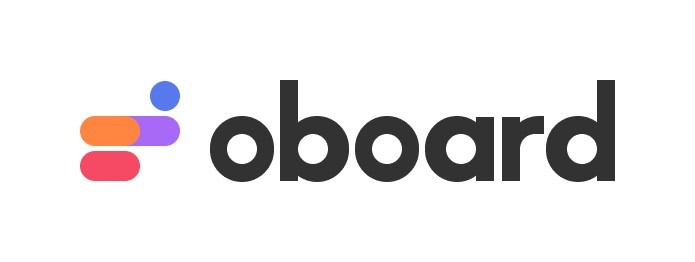
Unlike other apps on the list, Oboard lets you manage your OKRs directly where you work. It is a lean and efficient solution that plugs OKRs into your workflow instead of reinventing the wheel.
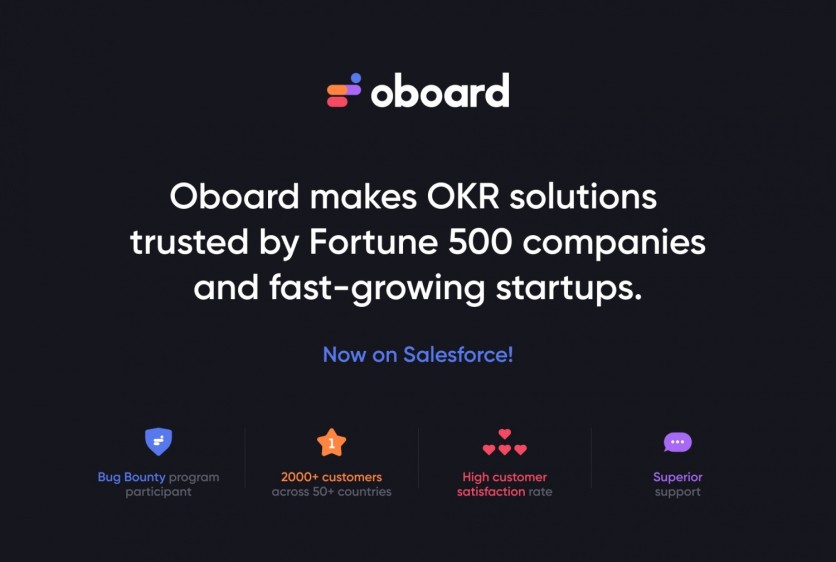
Oboard targets enterprises and other companies that already manage their projects with Jira or Salesforce and want to avoid adding extra busy work by duplicating their data in a third-party tool. Instead, Oboard offers a system that natively fits right into your existing workflow and requires only minimal adjustments. For example, Jira OKR Board lets you sync your OKRs with your Jira Epics and Tasks, automating the OKR maintenance and drastically reducing the need for back-and-forth communication between teams and departments.
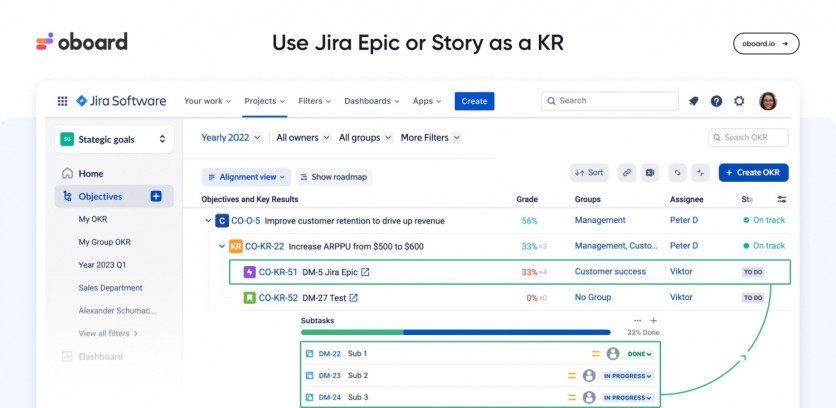
Oboard products also feature an advanced reporting system with real-time Dashboards. With a single click, you can get a complete performance report on any individual or team, structured the way you want. You can later share these Dashboards as executive reports or export them, i.e., as PDF files. There is even a public API for those teams that use external visualization tools.
Oboard also ensures that their customer succeeds with OKR adoption. An extensive onboarding, a Knowledge Base, an online OKR Academy, and even an OKR consulting service are available on demand. And if you are in doubt, you can schedule a demo and get a sense of how exactly OKRs and Oboard can make your team more productive.
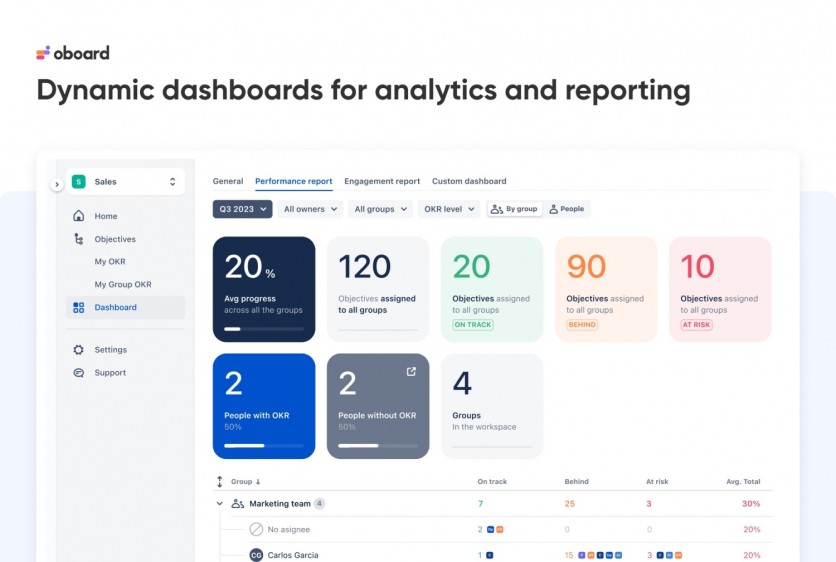
Key Features:
Task Sync. Tasks and Epics can be linked to Objectives and Key Results. Linked tasks update automatically, minimizing OKR maintenance.
Roadmaps. Track OKRs across several projects on a single cohesive Roadmap that automatically syncs all changes from your Jira tasks and epics.
Enhanced Security and Data Storage. Oboard participates in Security Self-Assessment and Bug Bounty Program on Atlassian Marketplace and has passed the Salesforce Security Review.
User-Friendly Design. OKR Board boasts a modern and streamlined user interface.
OKR Consulting. OKR consulting services are available for all companies and clients. Each case is handled personally, and you always get a coach that is ideally suited to your situation.
Public APIs. All data from the OKR Board can be exported into third-party tools, i.e., for visualization or advanced analytics.
Oboard's OKR Board for Jira is priced in accordance with the number of users, ranging from $0.09 to $1.5 per user per month, depending on the total number of users in the Jira instance. Their Salesforce OKR solution is more expensive at $10 per monthly user. Both feature a 30-day trial for those who wish to test drive the system before taking a plunge.
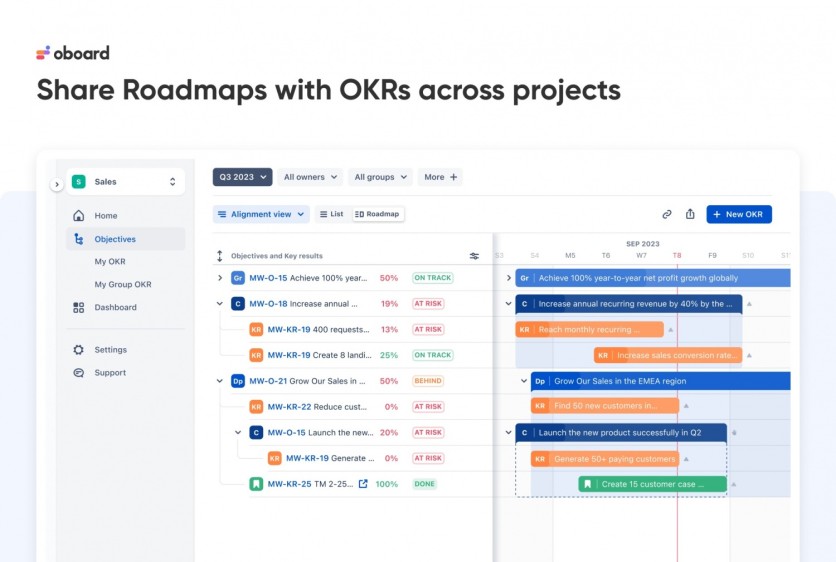
At the moment of writing, Oboard has over 2 000 customers split between Atlassian Marketplace and Salesforce AppExchange. They range from disruptive startups to Fortune 500 companies, further proving the flexibility of the OKR Boards for Jira and Salesforce. In addition, there are plans for a standalone app release later in 2023, with an option to sync data between all three OKR Board versions.
OKR Board for Confluence by Oboard
If you use Jira as your project management tool, you can expand your OKR arsenal with OKR Board for Confluence. It lets you synchronize your OKR Board for Jira with the Confluence OKR Knowledge Base and put your Dashboards directly onto your Confluence pages.
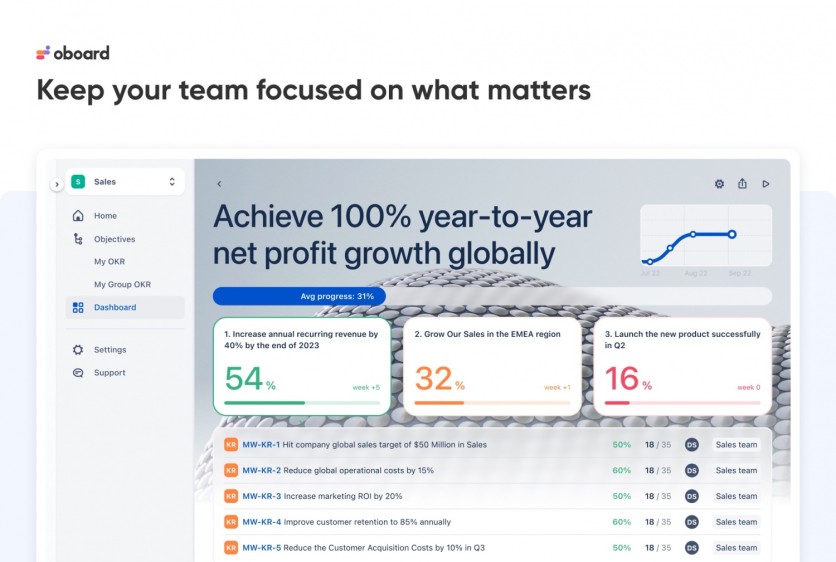
***
If you want to succeed with your OKR implementation, you need an OKR software, and Oboard has got you covered. Streamline your OKR management process by integrating it directly into your work environment with OKR Board for Jira or OKR Board for Salesforce, and eliminate the need for additional standalone apps or clumsy spreadsheets once and for all!
ⓒ 2026 TECHTIMES.com All rights reserved. Do not reproduce without permission.




